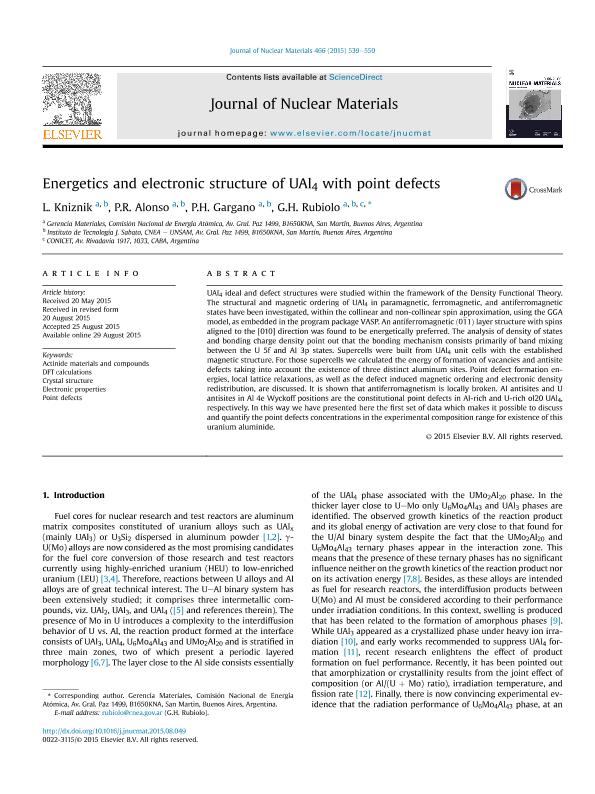Mostrar el registro sencillo del ítem
dc.contributor.author
Kniznik, Laura

dc.contributor.author
Alonso, Paula Regina

dc.contributor.author
Gargano, Pablo Hugo

dc.contributor.author
Rubiolo, Gerardo Hector

dc.date.available
2018-04-11T20:39:08Z
dc.date.issued
2015-08
dc.identifier.citation
Kniznik, Laura; Alonso, Paula Regina; Gargano, Pablo Hugo; Rubiolo, Gerardo Hector; Energetics and electronic structure of UAl4 with point defects; Elsevier Science; Journal of Nuclear Materials; 466; 8-2015; 539-550
dc.identifier.issn
0022-3115
dc.identifier.uri
http://hdl.handle.net/11336/41789
dc.description.abstract
UAl4 ideal and defect structures were studied within the framework of the Density Functional Theory. The structural and magnetic ordering of UAl4 in paramagnetic, ferromagnetic, and antiferromagnetic states have been investigated, within the collinear and non-collinear spin approximation, using the GGA model, as embedded in the program package VASP. An antiferromagnetic ð011Þ layer structure with spins aligned to the [010] direction was found to be energetically preferred. The analysis of density of states and bonding charge density point out that the bonding mechanism consists primarily of band mixing between the U 5f and Al 3p states. Supercells were built from UAl4 unit cells with the established magnetic structure. For those supercells we calculated the energy of formation of vacancies and antisite defects taking into account the existence of three distinct aluminum sites. Point defect formation energies, local lattice relaxations, as well as the defect induced magnetic ordering and electronic density redistribution, are discussed. It is shown that antiferromagnetism is locally broken. Al antisites and U antisites in Al 4e Wyckoff positions are the constitutional point defects in Al-rich and U-rich oI20 UAl4, respectively. In this way we have presented here the first set of data which makes it possible to discuss and quantify the point defects concentrations in the experimental composition range for existence of this uranium aluminide.
dc.format
application/pdf
dc.language.iso
eng
dc.publisher
Elsevier Science

dc.rights
info:eu-repo/semantics/openAccess
dc.rights.uri
https://creativecommons.org/licenses/by-nc-sa/2.5/ar/
dc.subject
Actinide Materials And Compounds
dc.subject
Dft Calculations
dc.subject
Crystal Structure
dc.subject
Electronic Properties
dc.subject.classification
Otras Ciencias Físicas

dc.subject.classification
Ciencias Físicas

dc.subject.classification
CIENCIAS NATURALES Y EXACTAS

dc.title
Energetics and electronic structure of UAl4 with point defects
dc.type
info:eu-repo/semantics/article
dc.type
info:ar-repo/semantics/artículo
dc.type
info:eu-repo/semantics/publishedVersion
dc.date.updated
2018-04-11T16:00:14Z
dc.journal.volume
466
dc.journal.pagination
539-550
dc.journal.pais
Países Bajos

dc.journal.ciudad
Amsterdam
dc.description.fil
Fil: Kniznik, Laura. Universidad Nacional de San Martín. Instituto Sabato; Argentina. Comisión Nacional de Energía Atómica; Argentina
dc.description.fil
Fil: Alonso, Paula Regina. Universidad Nacional de San Martín. Instituto Sabato; Argentina. Comisión Nacional de Energía Atómica; Argentina
dc.description.fil
Fil: Gargano, Pablo Hugo. Comisión Nacional de Energía Atómica; Argentina. Universidad Nacional de San Martín. Instituto Sabato; Argentina
dc.description.fil
Fil: Rubiolo, Gerardo Hector. Universidad Nacional de San Martín. Instituto Sabato; Argentina. Consejo Nacional de Investigaciones Científicas y Técnicas; Argentina
dc.journal.title
Journal of Nuclear Materials

dc.relation.alternativeid
info:eu-repo/semantics/altIdentifier/url/https://www.sciencedirect.com/science/article/pii/S0022311515301859
dc.relation.alternativeid
info:eu-repo/semantics/altIdentifier/doi/http://dx.doi.org/10.1016/j.jnucmat.2015.08.049
Archivos asociados
